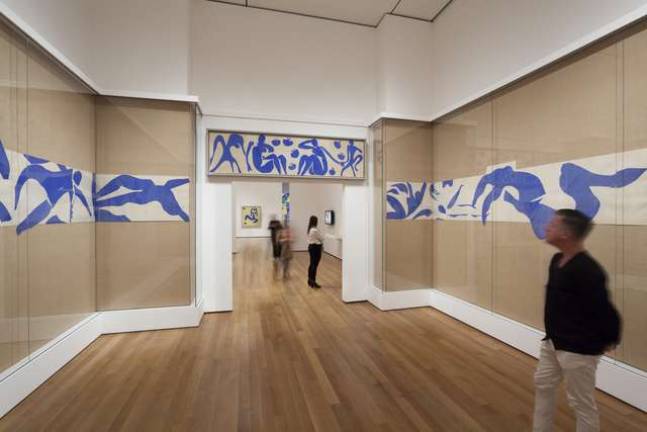Yes, they’re colorful, vibrant, expressive and ebullient. They can certainly be enjoyed as such. But a careful look at the cut-outs reveals fascinating stories about Matisse and his work. These lyrical compositions may look simple, but they have a radical and complicated side.
“Simple forms, complex ideas,” said curator Jodi Hauptman. Hauptman and her colleagues have pulled together a dazzling collection of works that more than just delight the eye (though they do that in an unbelievable way). They also tell us a great deal about Matisse, the artist.
Talking with Hauptman gave an idea of what the exhibition is trying to express, beyond the pure beauty of the works. “There are many narratives in an exhibition. There’s a chronological narrative, there’s a materials narrative, but there’s also, in this exhibition, definitely a sense of a shift in scale,” she said.
The first piece presented, Two Dancers, 1937-38, is a relatively small design for a ballet stage curtain. It’s a perfect choice because it shows so much of what is surprising in the cut-outs. Rather than the flat blocks of color seen in reproductions of the works, instead it’s almost like a mosaic, made not with chips of marble, but with innumerable shards of paper pinned together. The pins and pinholes, so evident in this work, are found throughout the exhibition. They’re intentionally emphasized, since they’re a crucial part of the story.
“The multiple pinholes show the labor,” Hauptman said. “You can kind of map how he moved one element and another element. A key part of the focus of this exhibition is the process, and the pinholes are a record of that process. So, if you’re interested in how artists work, you can almost see it in the work, itself. That’s exciting.”
The next group of works are maquettes for Matisse’s famous book, Jazz, which are rarely exhibited. “He begins working on Jazz in ‘43, and in ‘47 Jazz is published, and that’s a turning point because that’s when he realizes it’s a medium,” Hauptman said. Matisse largely put down his paintbrush after he picked up his scissors.
From there, the exhibition grows to include a focus on the scale of the works, and the idea that these were very early examples of what we now consider installation art (though the term didn’t exist at the time.) “He was one of the first people doing that,” Hauptman said. “His studio was a kind of installation.” Matisse made these works in the late 30s through the 40s and 50s.
They were difficult times, in many ways. He had survived a life-threatening illness and a difficult surgery, and spent a significant amount of time in a wheelchair. His mobility was further challenged, for some of those years, by living in occupied and war-torn France.
When it was impossible to go to the seashore, in 1946, he created Oceania, The Sea, a wall-sized cut-out filled with shapes -- jelly fish, starfish, sharks and eels. He used his vision and artistry to create his own reality within the walls of his studio.
“There’s a kind of myth out there,” Hauptman said, “that he stopped painting and he was cutting paper because he couldn’t paint anymore. We don’t really think that. We think that cutting paper was another way of dealing with certain pictorial challenges he had been addressing his whole life. Although he wasn’t in terrific shape…his inventiveness is not a result of being not well. He was still painting. He was still drawing. He was still at it in all sorts of ways.” Matisse talked about how these pieces allowed him to cut “directly into color,” Hauptman explained, and that his focus on color and line never changed. He was, she said, just “doing the same thing with different means.”
MoMA’s own The Swimming Pool from 1952 is Matisse’s largest cut-out. He installed it in his living room in Nice. Chief conservator, Karl Buchberg, and his team just completed a six-year long conservation, and built a replica of Matisse’s room in which to display it. The azure and white paper shapes, abstractions of figures, waves and starfish, surround the viewer. Pinholes are everywhere, and, while some of the shapes seem to have fallen from the scissors magically, in others, dozens of patched sections lay on top of each other to form a single figure. As Hauptman said, the record of the labor is clear, and the thought process is almost within reach.
The Swimming Pool and the spectacular The Parakeet and The Mermaid, a more than 20-foot-long work in brilliant blues, pinks and oranges, carry the exhibition into large-scale works, and bring out another piece of Matisse’s story. Matisse always wanted to do a public mural, but It didn’t happen. Still, he was looking for a way to expand the size of his work. The cut-outs made it possible.
The exhibition that began with book-sized sheets of paper closes with some of the largest cut-outs, deliberately chosen by the curators to show an arc of Matisse’s ambitions towards ever larger works. MoMa’s Memories of Oceania, at just about 10-by-10 feet, is an abstraction combining colors, shapes and drawn lines. The Snail (just as big) on loan from the Tate in London, is simple and bold, yet complex and brilliant. Facing them is the National Gallery’s Large Decoration with Masks spanning more than 30 feet of wall with resplendent color in a ballet of forms.
Fragile works on paper don’t spend much of their lives on view. This is the largest group of Matisse cut-outs ever displayed, on view through February 8, 2015. It’s a stunning show, and what Hauptman agrees is a “once in a lifetime” chance to see them.
Matisse’s cut-outs are innovative. They’re experimental. They’re radical. They’re elucidating. And, Hauptman added, “They’re glorious.”

